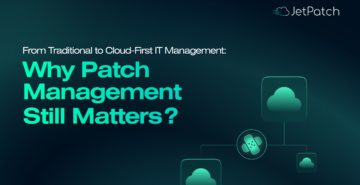If your organization is like most organizations, then your patching program is labor-intensive, manual, siloed, and having difficulty keeping up. In the brave new world of increasing cybersecurity threats and ever more stringent compliance requirements, legacy patching solutions are, quite simply, not good enough—and often more expensive than they have to be.
However, with the urgent often drowning out the important, it is rare for organizations to take a step back and analyze the strengths and weaknesses of their patching and vulnerability remediation programs. This blog post describes how JetPatch’s free Patch Assessment consultation can map your current patching processes and show you the path to next-generation vulnerability remediation and automation.
What Is Next-Generation Vulnerability Remediation?
Legacy patching solutions tend to suffer from a number of challenges, including:
- The involvement of multiple siloed teams (security, operations, development, business units, and so on), each with its own mandate, agenda, and toolset
- Cumbersome and tedious manual procedures, without clearly defined cross-team workflows
- Difficulties in tracking the patching process and verifying results
In order to address these challenges, companies are turning to next-generation cloud-based solutions that provide end-to-end automated patch management and vulnerability remediation. Working seamlessly with the company’s existing vulnerability scanners (Tenable, Qualys, Rapid7, and so on) and ITSM stack, next-generation vulnerability remediation eliminates patch blind spots and intelligently analyzes vulnerability scanner outputs to achieve continuous and actionable vulnerability and patch monitoring. It shortens time-to-remediation via consistent processes across all environments and automated testing-staging-rollout workflows.
Patch Assessment Accelerates the Path to Optimized Patching
How It Works
JetPatch’s experts conduct a phone interview with your core patching and vulnerability management team in order to model the company’s current patching processes and procedures. Some of the questions they’ll cover include:
- How does your vulnerability management team ascertain that all assets are being scanned and remediated in a risk-appropriate timeframe?
- How many teams are involved in the patching process, from vulnerability detection, to prioritization, to patch testing and rollout?
- Does your patching process empower all key stakeholders, including line of business owners, DevOps, the security team, and audit/compliance teams?
- Do you have different patching processes and tools for each environment under management, such as Windows, Linux, and Solaris?
- How many “handshakes” are involved in your patching workflows?
- How many activities and tasks are passed from one team to another, and who verifies that any given leg has been successfully completed before the next is triggered?
- How many hours are spent on patching per week? Per month?
- How can your patching team verify that a patch rollout has been successful?
- How many hours per month does your company spend on compliance reporting, and does it result in a complete, comprehensive accounting?
Expected ROI
In the spirit of modern IT, your goal is to give your cross-organizational patching team the ability to do more with less. JetPatch’s consultants analyze the information provided and create a snapshot of your current patching process, with recommendations on how it can be improved and streamlined. The team will build a simulation of what your patch process would look like were you to adopt its next-generation patching and vulnerability remediation platform. The simulation will show how the solution would enhance coverage, time-to-remediation, and other patching and vulnerability remediation KPIs while reducing costs via:
- Automation workflow templates that standardize, streamline, and optimize the patching process, addressing all actions needed before and after the actual patch rollout
- Centralized policy management that lets you implement a governed best-practice patching process consistently, across all stakeholders
- Continuous compliance for endpoints and hosts as well as a more efficient patching process that reduces time to remediation and enhances the organization’s security posture
- Smart agent management that optimizes deployment and monitors the status of security-related tools (configuration management, anti-virus, backup, and so on) across even the most complex hybrid environment
- Predictive Patching machine learning technology, which enables organizations to be proactive in their patching approach, eliminate process flaws prior to patching cycle execution and achieve a much higher patching success rate and continuous compliance.
Implementation of the JetPatch platform has been shown to reduce:
- Manual efforts in patching cycles by 70%
- System downtime during patching cycles by 70%
- Time to remediation by 75%
As shown in the sample report to the right, the JetPatch Patch Assessment team will quantify how these efficiencies would reduce your organization’s patching costs over time and clearly show the number of months it would take for your company to see a return on its investment in the platform.
Learn More
To learn more about JetPatch’s free Patch Assessment consultation, download the datasheet, and visit the ROI calculator page to validate your existing business model.



